Pipestone County, Minnesota
| Pipestone County, Minnesota | |
|---|---|
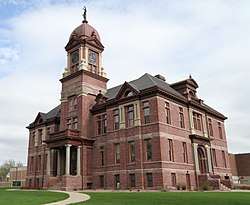 | |
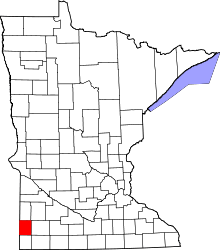 Location in the U.S. state of Minnesota | |
 Minnesota's location in the U.S. | |
| Founded |
May 23, 1857 (created) 1879 (organized)[1] |
| Named for | Pipestone |
| Seat | Pipestone |
| Largest city | Pipestone |
| Area | |
| • Total | 466 sq mi (1,207 km2) |
| • Land | 465 sq mi (1,204 km2) |
| • Water | 0.9 sq mi (2 km2), 0.2% |
| Population (est.) | |
| • (2016) | 9,202 |
| • Density | 21/sq mi (8/km2) |
| Congressional district | 7th |
| Time zone | Central: UTC−6/−5 |
| Website |
www |
Pipestone County is a county located in the U.S. state of Minnesota. As of the 2010 census, the population was 9,596.[2] Its county seat is Pipestone.[3] The county was founded in 1857 and organized in 1879. The county was named for deposits of red pipestone used by Native Americans to make pipes.[4]
Pipestone National Monument is located in the county, just north of the town of Pipestone.
Geography
According to the U.S. Census Bureau, the county has a total area of 466 square miles (1,210 km2), of which 465 square miles (1,200 km2) is land and 0.9 square miles (2.3 km2) (0.2%) is water.[5]
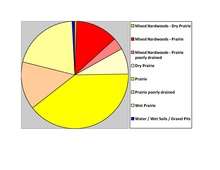
Lakes
Despite Pipestone County not containing any natural lakes (the other three being Mower, Olmstead and Rock), it does have one man-made reservoir created by a dam.
- Split Rock Lake: Eden Township, in Split Rock Creek State Park
Major highways
Adjacent counties
- Lincoln County (north)
- Lyon County (northeast)
- Murray County (east)
- Rock County (south)
- Minnehaha County, South Dakota (southwest)
- Moody County, South Dakota (west)
- Brookings County, South Dakota (northwest)
National protected area
Demographics
| Historical population | |||
|---|---|---|---|
| Census | Pop. | %± | |
| 1880 | 2,092 | — | |
| 1890 | 5,132 | 145.3% | |
| 1900 | 9,264 | 80.5% | |
| 1910 | 9,553 | 3.1% | |
| 1920 | 12,050 | 26.1% | |
| 1930 | 12,238 | 1.6% | |
| 1940 | 13,794 | 12.7% | |
| 1950 | 14,003 | 1.5% | |
| 1960 | 13,605 | −2.8% | |
| 1970 | 12,791 | −6.0% | |
| 1980 | 11,690 | −8.6% | |
| 1990 | 10,491 | −10.3% | |
| 2000 | 9,895 | −5.7% | |
| 2010 | 9,596 | −3.0% | |
| Est. 2016 | 9,202 | [7] | −4.1% |
| U.S. Decennial Census[8] 1790-1960[9] 1900-1990[10] 1990-2000[11] 2010-2016[2] | |||
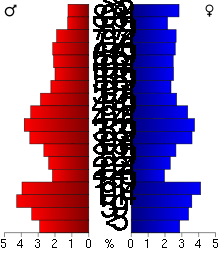
As of the 2000 census,[12] there were 9,895 people, 4,069 households, and 2,726 families residing in the county. The population density was 21 people per square mile (8/km²). There were 4,434 housing units at an average density of 10 per square mile (4/km²). The racial makeup of the county was 96.68% White, 0.17% Black or African American, 1.48% Native American, 0.46% Asian, 0.02% Pacific Islander, 0.26% from other races, and 0.93% from two or more races. 0.70% of the population were Hispanic or Latino of any race. 35.7% were of German, 24.8% Dutch and 14.3% Norwegian ancestry.
There were 4,069 households out of which 31.00% had children under the age of 18 living with them, 57.60% were married couples living together, 6.50% had a female householder with no husband present, and 33.00% were non-families. 30.10% of all households were made up of individuals and 17.20% had someone living alone who was 65 years of age or older. The average household size was 2.38 and the average family size was 2.96.
In the county, the population was spread out with 25.80% under the age of 18, 6.80% from 18 to 24, 24.60% from 25 to 44, 21.40% from 45 to 64, and 21.30% who were 65 years of age or older. The median age was 40 years. For every 100 females there were 92.80 males. For every 100 females age 18 and over, there were 89.40 males.
The median income for a household in the county was $31,909, and the median income for a family was $40,133. Males had a median income of $27,642 versus $20,759 for females. The per capita income for the county was $16,450. About 7.80% of families and 9.50% of the population were below the poverty line, including 11.20% of those under age 18 and 11.10% of those age 65 or over.
Communities
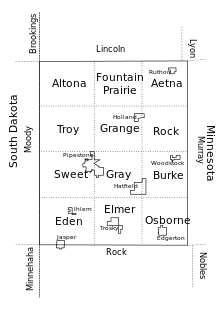
Cities
Townships
Unincorporated communities
Politics
| Year | Republican | Democratic | Third parties |
|---|---|---|---|
| 2016 | 69.4% 3,338 | 23.4% 1,127 | 7.1% 343 |
| 2012 | 60.8% 2,826 | 37.1% 1,725 | 2.0% 95 |
| 2008 | 55.2% 2,652 | 42.1% 2,023 | 2.6% 126 |
| 2004 | 60.9% 3,066 | 37.8% 1,900 | 1.3% 66 |
| 2000 | 55.0% 2,693 | 40.3% 1,970 | 4.7% 231 |
| 1996 | 44.4% 2,096 | 42.3% 1,999 | 13.3% 627 |
| 1992 | 37.8% 1,953 | 34.3% 1,773 | 27.9% 1,444 |
| 1988 | 53.2% 2,760 | 45.9% 2,382 | 0.9% 47 |
| 1984 | 55.3% 3,043 | 43.5% 2,391 | 1.2% 67 |
| 1980 | 51.4% 3,207 | 38.3% 2,392 | 10.3% 644 |
| 1976 | 47.2% 3,018 | 51.1% 3,272 | 1.7% 111 |
| 1972 | 55.6% 3,543 | 43.3% 2,758 | 1.2% 75 |
| 1968 | 56.5% 3,241 | 38.9% 2,234 | 4.6% 263 |
| 1964 | 42.4% 2,481 | 57.5% 3,365 | 0.1% 5 |
| 1960 | 60.0% 3,677 | 39.9% 2,443 | 0.2% 11 |
| 1956 | 60.8% 3,362 | 39.1% 2,165 | 0.1% 6 |
| 1952 | 72.5% 4,507 | 27.3% 1,701 | 0.2% 13 |
| 1948 | 44.0% 2,281 | 54.1% 2,804 | 1.8% 95 |
| 1944 | 57.0% 2,844 | 42.6% 2,129 | 0.4% 21 |
| 1940 | 58.6% 3,423 | 40.9% 2,390 | 0.5% 29 |
| 1936 | 36.4% 1,881 | 58.5% 3,026 | 5.1% 263 |
| 1932 | 33.0% 1,509 | 65.4% 2,996 | 1.6% 73 |
| 1928 | 61.3% 2,578 | 37.8% 1,591 | 0.9% 38 |
| 1924 | 48.2% 2,066 | 5.1% 219 | 46.7% 2,005 |
| 1920 | 79.9% 3,106 | 12.6% 490 | 7.5% 292 |
| 1916 | 52.4% 1,010 | 38.0% 732 | 9.6% 184 |
| 1912 | 18.1% 301 | 30.4% 505 | 51.6% 858 |
| 1908 | 65.1% 1,057 | 30.2% 491 | 4.7% 76 |
| 1904 | 76.2% 1,185 | 17.3% 269 | 6.6% 102 |
| 1900 | 59.9% 1,112 | 37.2% 692 | 2.9% 54 |
| 1896 | 47.5% 862 | 50.6% 919 | 1.9% 34 |
| 1892 | 48.0% 648 | 21.8% 295 | 30.2% 408 |
See also
References
- ↑ "Minnesota Place Names". Minnesota Historical Society. Retrieved March 19, 2014.
- 1 2 "State & County QuickFacts". United States Census Bureau. Archived from the original on July 16, 2011. Retrieved September 1, 2013.
- ↑ "Find a County". National Association of Counties. Archived from the original on May 31, 2011. Retrieved 2011-06-07.
- ↑ Chicago and North Western Railway Company (1908). A History of the Origin of the Place Names Connected with the Chicago & North Western and Chicago, St. Paul, Minneapolis & Omaha Railways. p. 163.
- ↑ "2010 Census Gazetteer Files". United States Census Bureau. August 22, 2012. Archived from the original on September 21, 2013. Retrieved October 24, 2014.
- ↑ Nelson, Steven (2011). Savanna Soils of Minnesota. Minnesota: Self. pp. 69-70. ISBN 978-0-615-50320-2.
- ↑ "Population and Housing Unit Estimates". Retrieved June 9, 2017.
- ↑ "U.S. Decennial Census". United States Census Bureau. Archived from the original on May 12, 2015. Retrieved October 24, 2014.
- ↑ "Historical Census Browser". University of Virginia Library. Retrieved October 24, 2014.
- ↑ "Population of Counties by Decennial Census: 1900 to 1990". United States Census Bureau. Retrieved October 24, 2014.
- ↑ "Census 2000 PHC-T-4. Ranking Tables for Counties: 1990 and 2000" (PDF). United States Census Bureau. Retrieved October 24, 2014.
- ↑ "American FactFinder". United States Census Bureau. Retrieved 2008-01-31.
- ↑ Leip, David. "Dave Leip's Atlas of U.S. Presidential Elections". uselectionatlas.org. Retrieved 10 October 2018.